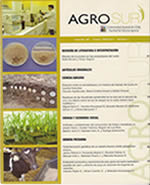CHARACTERIZATION OF SHEEP PRODUCTION IN PEASANT FARMING IN PAILLACO, REGION DE LOS RIOS, CHILE
Main Article Content
Abstract
Small livestock is an important item for small producers, since it requires less space for breeding and is a quick source of income to face unexpected economic problems. In this context, the purpose of this study is to analyze socio-economic, productive, reproductive and marketing aspects of sheep management in peasant farming in Paillaco municipality, Region de los Ríos, Chile.
Between January and February 2011, sheep producers from the Local Development Program (PRODESAL) and the Indigenous Land Development Program (PDTI) in Paillaco municipality were surveyed, including 32% (n = 51) of users. Socio-economic variables were evaluated. Age, body condition (BC) and some technical indexes (results 2010) were determined in the livestock. Date were analyzed through descriptive statistics of position and dispersion, using the SPSS software.
The average size of the farms in the area under survey is 15 ± 8 ha. The average age of the producers is 56 years old. 66% of them completed primary school and only 6% did not attend school. Incomes are low, not exceeding $ 100,000 Chilean pesos (US$ 200) monthly in 41% of cases. All the producers receive technical assistance and apply antiparasitic treatments and vaccines. The following averages were obtained: fertility rate (93 to 100%), prolificacy (100 to 191%), weaning (62 to 167%) and lamb mortality (0 to 36%). The lambs are sold informally at the farm, and at attractive prices $ 35,000 (US$ 70) to $ 60,000 (US$ 120) per head) while wool clothing is intended for either family use or to be sold at low prices. The sheep business is perceived as attractive and there is an interest in increasing the mass, noticing a large potential improvement in the area of productive results.

